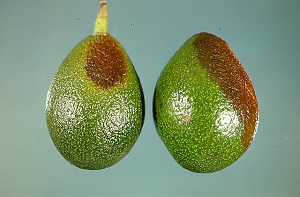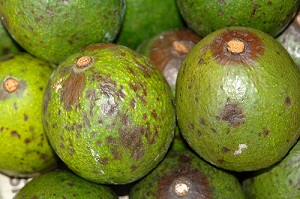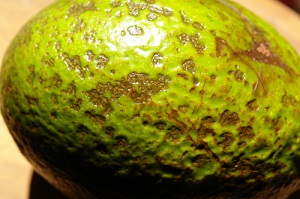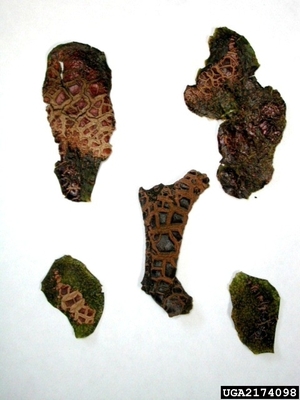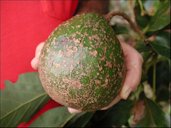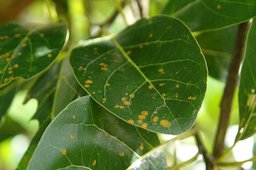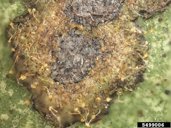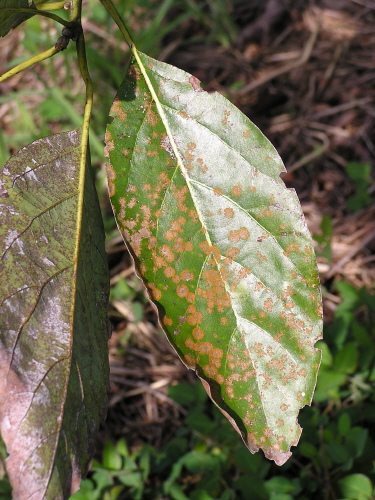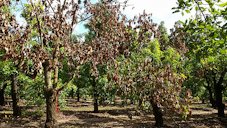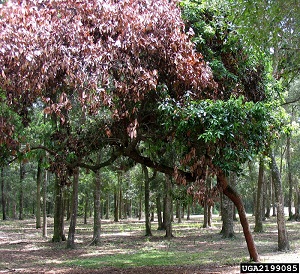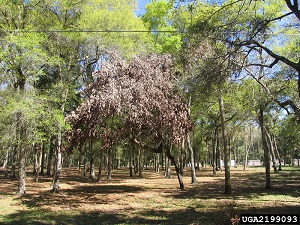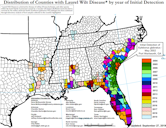| Avocado Diseases | ||||||||||||||||||||||||||||||||||
|---|---|---|---|---|---|---|---|---|---|---|---|---|---|---|---|---|---|---|---|---|---|---|---|---|---|---|---|---|---|---|---|---|---|---|
| Back to Avocado Page 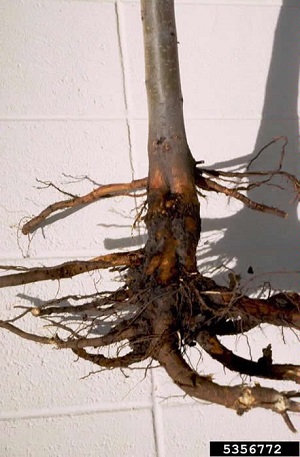 Fig. 1 Phytophthora root rot 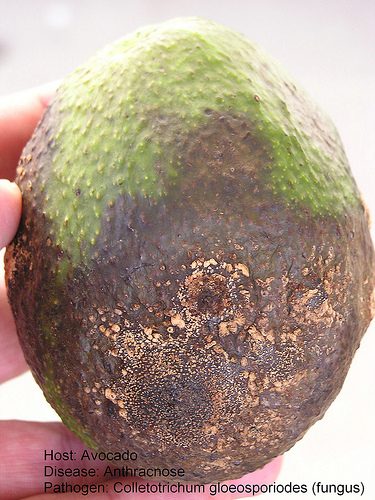 Fig.
2 Fig.
2 Avocado anthracnose lesions 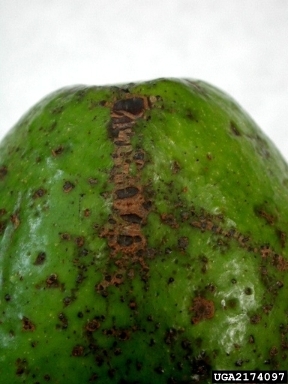 Fig. 7 Avocado scab 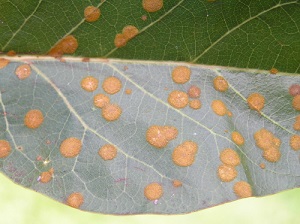 Fig. 10  Algal spot of avocado (Persea americana) in Hilo, Hawai'i, caused by Cephaleuros virescens. 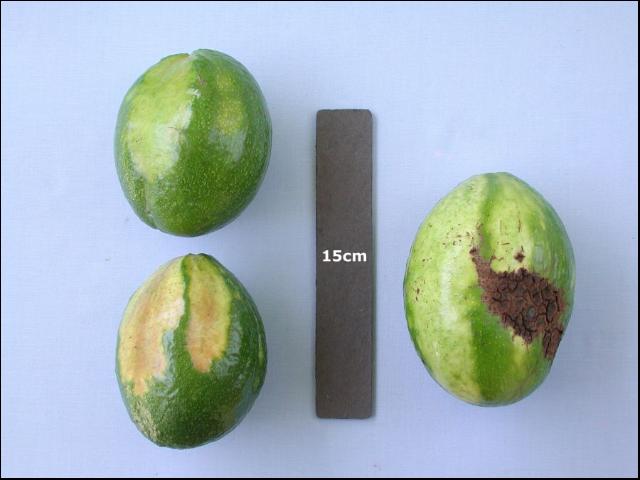 Fig.
15 Fig.
15Sunblotch 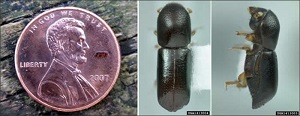 Fig. 16  Redbay ambrosia beetles (Xyleborus glabratus): a) comparison of beetle to a penny; b) top view and c) side view of a single adult.
| Disease
control for
avocado trees in the
home landscape is usually not warranted. The easiest method for
avoiding disease problems is to grow scab resistant varieties, planting
trees only in well drained soils, and monitoring the tree (leaves and
fruit specially) during the year. 3
Successful control of foliar and fruit diseases caused by fungi requires that all susceptible parts of the plant be thoroughly coated with the fungicide before infection occurs. Sprays applied after infection (which usually occurs several days before the disease is evident) often have limited to no effect on disease development. Sprays must be re-applied as new tissues become exposed by growth and as spray residues are reduced by weathering. A successful program depends on: • Use of the right amount of a recommended fungicide and adjuvant, if required • Timely applications before infection is most likely to occur • Thorough coverage of susceptible parts Homeowners should contact their local UF/IFAS Extension office for current control recommendations for the diseases discussed below. 3 Avocado Root Rot (Fig. 1) Caused by Phytophthora cinnamomi Trees in areas with poorly drained soils and/or which are subject to flooding are likely to be affected by this fungus. This is the most serious disease in most avocado producing areas of the world. Although many trees are infected with the fungus in Florida, the disease appears to be serious only if trees are subjected to flooded conditions. Leaves of infected trees may be pale green, wilted, or dead, and terminal branches die back in advanced stages of the disease. Feeder roots become darkened and decayed, and severely affected trees usually die. 3 Anthracnose (Fig. 2) Caused by Colletotrichum gloeosporioides Anthracnose infects the leaves and the fruit of the avocado plant. It is a weak pathogen, requiring entry portals, which may be created by Sphaceloma perseae or Cercospora purpurea. Once the fruit is infected, however, the anthracnose fungus rapidly degrades the quality of maturing fruit. Lesions become black and sunken, and a large portion of the fruit can also be overcome with the black decay. 1
Further Reading Anthracnose of Avocado, University of Hawai'i at Mānoa pdf Avocado Scab (Fig. 7) Caused by Sphaceloma persea The scab fungus readily infects young, succulent tissues of leaves, twigs and fruit. These tissues become resistant as they mature. Lesions appear as small, dark spots visible on both sides of the leaves. Spots on leaf veins, petioles and twigs are slightly raised, and oval to elongated. Severe infections distort and stunt leaves. Spots on fruits are dark, oval and raised and eventually coalesce to form cracked and corky areas which impair the appearance but not the internal quality of the fruit (Fig, 9). Begin a spray program for scab prevention when bloom buds begin to swell and continue spraying until harvest. Many avocado varieties are resistant or moderately resistant to scab and no control is necessary. Some varietes such as 'Lula' are very susceptible to scab and are not recommended for planting in the home landscape. 3
Algal Leaf Spot (Fig. 10) Caused by Cephaleuros virescens This is a relatively minor disease that occurs most frequently in tropical avocado production areas; it is fairly common on avocado in south Florida. 2 Symptoms appear first on upper leaf surfaces as green, yellowish-green, or rust-colored, roughly circular spots. This disease is most prevalent during summer and fall months. 3
Further Reading Cephaleuros Species, the Plant-Parasitic Green Algae, University of Hawai'i at Mānoa pdf Sun-blotch (Fig. 15) Caused by a viroid (ASBVD) Symptoms of infection include sunken yellow or whitish streaking or spotting and distortion of twigs, leaves, and fruit. It is transmitted through buds, seeds, and root-grafting of infected trees. There is no control for this disease, and infected trees should be destroyed. This disease is rare in Florida. 3 Laurel Wilt Caused by the Redbay Ambrosia Beetle (Xyleborus glabratus) The redbay ambrosia beetle, Xyleborus glabratus Eichhoff and its fungal symbiont, Raffaelea sp., are new introductions into the southeastern United States. Xyleborus glabratus was first detected in 2002 and is one of the 10 ambrosia beetle species in the US (Haack 2003, 2006). The beetle transmits the causal pathogen of laurel wilt disease among plants in the Laurel family (Lauraceae), which is caused by one of its fungal symbionts, Raffaelea lauricola (Mayfield and Thomas 2006, Fraedrich et al. 2009). The X. glabratus and R. lauricola complex is considered a "very high risk" invasive disease pest complex having potential equal to that of Dutch elm disease or chestnut blight (Global Invasive Species Database 2010). Laurel wilt is a relatively new disease and much is still unknown about how it will impact the flora of North America. 4 A battle is being waged in the avocado groves of South Florida where the region’s largest and most economically important fruit crop is under attack. Avocados account for approximately 6,600 acres in Miami-Dade County and have an economic impact of $54 million to the regional economy. The avocado industry has already lost over 120,000 trees due to laurel wilt since the introduction of the disease to Miami-Dade County in 2011. 5
Fig. 17. Avocado trees infected with laurel wilt disease. Trees can die just 6 to 8 weeks after infection. Fig. 18. Redbay with partially wilted crown Fig. 19. Same tree eight months later Fig. 20. Distribution of laurel wilt disease in the United States as of 2019
Further Reading An Avocado Tree’s Worst Nightmare, VSCNews UF/IFAS Researchers Honored for Avocado Integrated Pest Management, VSCNews UF/IFAS scientists find potential biological control for avocado-ravaging disease, University of Florida News Avocado Alarm: Laurel Wilt, Edible South Florida Brochure for the Homeowner, University of Florida TREC pdf Redbay Ambrosia Beetle Xyleborus glabratus Eichhoff, University of Florida pdf Recommendations for the Detection and Mitigation of Laurel Wilt Disease in Avocado and Related Tree Species in the Home Landscape, University of Florida pdf Recommendations for Control and Mitigation of Laurel Wilt and Ambrosia Beetle Vectors in Commercial Avocado Groves in Florida, Unitversity of Florida TREC Recovery Plan for Laurel Wilt on Redbay and Other Forest Species, The American Phytopathological Society pdf Links Laurel Wilt of Avocado, University of Florida TREC ext. link Scouting for the Redbay Ambrosia Beetle – Laurel Wilt Pathogen Infestation of Avocado Trees, University of Florida TREC ext. link Laurel Wilt Disease, Florida Dept. of Agriculture and Consumer Services ext. link Powdery Mildew Caused by an Oidium sp. Powdery mildew covers undersides of leaves with a white powdery growth. Later, the white mildew disappears leaving dark, reticulate markings, which appear from the upper side as yellowish areas. Usually not serious enough to require control measures, this disease is most prevalent during the dry season. 3 Cercospora Spot Caused by Cercospora purpurea Infection appears on fruits and leaves as small, angular, dark brown spots which coalesce to form irregular patches. These spots have a yellow halo. Fruit lesions are frequently the point of entry for other decay organisms, such as the anthracnose fungus. Infection usually occurs during the summer months. If Cercospora spot is a problem begin a spray program for Cercospora prevention about May 1st and continue until harvest. 3 Diplodia Stem-end Rot Caused by Diplodia sp. This rot disease begins at the stem end of the fruit and develops as the fruit softens. It is usually only aproblem with immature fruit after harvest and can be prevented by harvesting only mature fruit. 3 Further Reading Identify the Causes of Fruit Damage, University of California ext. link Avocado Growing in the Florida Landscape, University of Florida pdf | |||||||||||||||||||||||||||||||||
| Bibliography 1 Nelson, Scot C. "Anthracnose of Avocado." University of Hawai'i at Mānoa. College of Agricuture and Human Resources, Department of Plant and Environmental Protection Sciences, 2008, CTAHR, hawaiiplantdiseases.net. Accessed 15 Oct. 2013. 2 Nelson, Scot C. "Cephaleuros Species, the Plant-Parasitic Green Algae." University of Hawai'i at Mānoa, College of Agricuture and Human Resources, Department of Plant and Environmental Protection Sciences, 2008, CTAHR, hawaiiplantdiseases.net. Accessed 12 Nov. 2013. 3 Crane, Jonathan H., et al. "Avocados Growing in the Home Landscape." Horticultural Sciences Department, University of Florida, IFAS Extension, CIR1034, First published as FC-3: Mar. 1983, Revised Jan. 1998, Aug. 2001, May 2003, Sept. 2005, Aug. 2007 and Sept. 2016, Reviewed Dec. 2019, EDIS, edis.ifas.ufl.edu/mg213. Accessed 13 June 2018, 16 Apr. 2020. 4 Crane, Jonathan H., et al. "Recommendations for the Detection and Mitigation of Laurel Wilt Disease in Avocado and Related Tree Species in the Home Landscape." Horticultural Sciences Department, Universitty of Florida, IFAS Extension, HS1358, Original pub. Feb. 2020, EDIS, edis.ifas.ufl.edu/hs1358. Accessed 1 May 2020. 5 Wasielewski, Jeff. "Laurel Wilt, A Disease Impacting Avocados." University of Florida, IFAS Extension, sfyl.ifas.ufl.edu/miami-dade/agriculture/laurel-wilt---a-disease-impacting-avocados/. Accessed 21 June 2018, 2 May 2020. Videos v1 Crane, Johathan H. and Ian Maguire. "Cultural practices for the avocado." University of Florida, IFAS/TREC. v2 "Laurel Wilt in Florida, Slowing the Spread." Florida Department of Agriculture and Consumer Services, www.fdacs.gov/Agriculture-Industry/Pests-and-Diseases/Plant-Pests-and-Diseases/Laurel-Wilt-Disease. Accessed 1 May 2020. Photographs Fig.1 Brown, William M. Jr. "Phytophthora root and crown rot." 2008. Colorado State Affiliation, Bugwood.org, bugwood.org. Accessed 10 Nov. 2013. Fig.6,14 Palmateer, Aaron J., et al. "2006 Florida Plant Disease Management Guide: Avocado (Persea americana)." Plant Pathology Department, University of Florida, IFAS Extension, 2006, EDIS, edis.ifas.ufl.edu. Accessed 15 Oct. 2013. Fig. 7,8 Calderon, Cesar. "Avocado Scab." USDA, APHIS, PPQ, University of Georgia, 2009, Bugwood.org, bugwood.org. Accessed 10 Nov. 2013. Fig.9 Maguire, Ian. Horticultural Sciences Department, University of Florida, IFAS Extension, EDIS, edis.ifas.ufl.edu/mg213. Accessed 2 May 2020. Fig.12 Calderon, Cesar. "Green Alga Cephaleuros virescens Kunze." USDA, APHIS, PPQ, University of Georgia, 2010, Bugwood.org, bugwood.org. Accessed 10 Nov. 2013. Fig.2,3,4,5,6,10,11,13,14 Nelson, Scot C. "An Illustrated Glossary of Tropical Plant Pest and Diseases." University of Hawai'i at Mānoa. College of Agriculture and Human Resources, Department of Plant and Environmental Protection Sciences, 2007, CTAHR, hawaiiplantdiseases.net. Accessed 12 Nov. 2013. Fig.15 Maguire, Ian. Horticultural Sciences Department, University of Florida, IFAS Extension, EDIS, edis.ifas.ufl.edu. Accessed 13 Nov. 2013. Fig. 16 Thomas, Michael C. "Redbay ambrosia beetles (Xyleborus glabratus): a) comparison of beetle to a penny; b) top view and c) side view of a single adult." Florida Department of Agriculture and Consumer Services, edis.ifas.ufl.edu. Accessed 19 Nov. 2013. Fig. 17 Kendra, Paul. "Avocado trees infected with laurel wilt disease. Trees can die just 6 to 8 weeks after infection." USDA Agricultural Research Service, Tropical Plant Genetic Resources and Disease Research (TPGRDR) unit at the Pacific Basin Agricultural Research Center (PBARC), Hilo, HI. no. D3703-1, USDA/ARS, www.ars.usda.gov/oc/images/photos/nov16/d3703-1/ Accessed 1 May 2020. Fig. 18,20 Mayfield III, Albert E. "Wilt symptoms of redbay attacked by Xyleborus glabratus and infected with Raffaelea lauricola." Florida Division of Forestry and M. C. Thomas, 2006, FDACS/DPI, freshfromflorida.com. Accessed 9 Feb. 2014. Fig. 20 "Distribution of laurel wilt disease in the United States as of 2019." US Forest Service, 11 Dec. 2019, USDA, www.fs.usda.gov/main/r8/forest-grasslandhealth. Accessed 1 May 2020. Published 16 Nov. 2013 LR. Last update 2 May 2020 LR | ||||||||||||||||||||||||||||||||||
